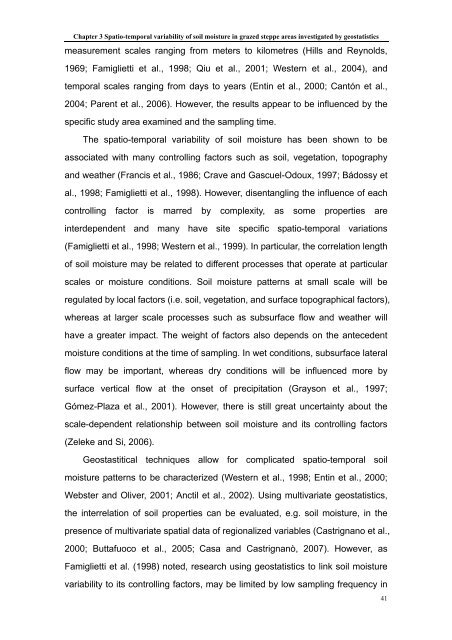SCHRIFTENREIHE Institut für Pflanzenernährung und Bodenkunde ...
SCHRIFTENREIHE Institut für Pflanzenernährung und Bodenkunde ...
SCHRIFTENREIHE Institut für Pflanzenernährung und Bodenkunde ...
You also want an ePaper? Increase the reach of your titles
YUMPU automatically turns print PDFs into web optimized ePapers that Google loves.
Chapter 3 Spatio-temporal variability of soil moisture in grazed steppe areas investigated by geostatistics<br />
measurement scales ranging from meters to kilometres (Hills and Reynolds,<br />
1969; Famiglietti et al., 1998; Qiu et al., 2001; Western et al., 2004), and<br />
temporal scales ranging from days to years (Entin et al., 2000; Cantόn et al.,<br />
2004; Parent et al., 2006). However, the results appear to be influenced by the<br />
specific study area examined and the sampling time.<br />
The spatio-temporal variability of soil moisture has been shown to be<br />
associated with many controlling factors such as soil, vegetation, topography<br />
and weather (Francis et al., 1986; Crave and Gascuel-Odoux, 1997; Bádossy et<br />
al., 1998; Famiglietti et al., 1998). However, disentangling the influence of each<br />
controlling factor is marred by complexity, as some properties are<br />
interdependent and many have site specific spatio-temporal variations<br />
(Famiglietti et al., 1998; Western et al., 1999). In particular, the correlation length<br />
of soil moisture may be related to different processes that operate at particular<br />
scales or moisture conditions. Soil moisture patterns at small scale will be<br />
regulated by local factors (i.e. soil, vegetation, and surface topographical factors),<br />
whereas at larger scale processes such as subsurface flow and weather will<br />
have a greater impact. The weight of factors also depends on the antecedent<br />
moisture conditions at the time of sampling. In wet conditions, subsurface lateral<br />
flow may be important, whereas dry conditions will be influenced more by<br />
surface vertical flow at the onset of precipitation (Grayson et al., 1997;<br />
Gómez-Plaza et al., 2001). However, there is still great uncertainty about the<br />
scale-dependent relationship between soil moisture and its controlling factors<br />
(Zeleke and Si, 2006).<br />
Geostastitical techniques allow for complicated spatio-temporal soil<br />
moisture patterns to be characterized (Western et al., 1998; Entin et al., 2000;<br />
Webster and Oliver, 2001; Anctil et al., 2002). Using multivariate geostatistics,<br />
the interrelation of soil properties can be evaluated, e.g. soil moisture, in the<br />
presence of multivariate spatial data of regionalized variables (Castrignano et al.,<br />
2000; Buttafuoco et al., 2005; Casa and Castrignanò, 2007). However, as<br />
Famiglietti et al. (1998) noted, research using geostatistics to link soil moisture<br />
variability to its controlling factors, may be limited by low sampling frequency in<br />
41


